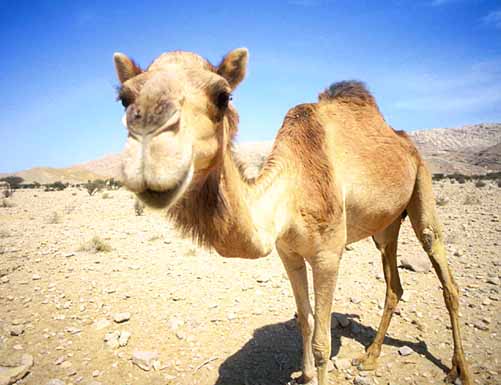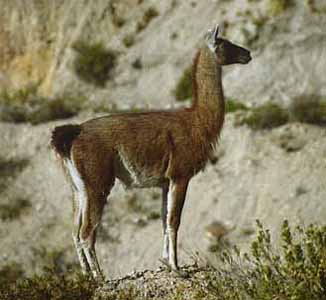MAMMALS
OF THE WORLD:
CAMELS
& CAMELOIDS
All photos taken
in the wild
 There
are six species of camels (family Camelidae)
alive today but almost are are domesticated. Even this free-range Dromedary
Camelus
dromedarius (right) encountered in the back country of Oman
belonged to someone. There are no wild dromedaries left. They have a long
history as an integral part of the lifestyle of Saharan and Arabian nomadic
peoples. Ninety percent (90%) of the 14 million camels in the world are
domesticated dromedaries. Introduced feral dromedaries also wander the
interior of Australia.
There
are six species of camels (family Camelidae)
alive today but almost are are domesticated. Even this free-range Dromedary
Camelus
dromedarius (right) encountered in the back country of Oman
belonged to someone. There are no wild dromedaries left. They have a long
history as an integral part of the lifestyle of Saharan and Arabian nomadic
peoples. Ninety percent (90%) of the 14 million camels in the world are
domesticated dromedaries. Introduced feral dromedaries also wander the
interior of Australia.
The only wild camel in the Old World is the two-humped Bactrian Camel
Camelus
bactrianus of the Mongolian steppes. There is a tiny wild population
among the thousands of domesticated Bactrians in that remote corner of
the world. Vladimir Dinets has a photo of wild Bactrian Camels on his web
page.
Old World camels are famous for their humps in which they store energy-rich
fats that enable them to survive for long periods without food. They can
also go for months without water (up to 10 months if not working) and so
can graze far from desert oases. When they do drink, though, they can tank
up on 30 gallons in a very short time!
 There are four cameloids in the Andes of South America but two of them
are entirely domesticated: the Alpaca Lama pacos (left)
and the Llama L. glama. Estimates from Macdonald (1984) were 3.7
million llamas (70% in Bolivia) and 3.3 million alpacas (91% in Peru where
this shot was taken). The wild non-domesticated cameloids are the Guanaco
L.
gunaicoe (96% in Argentina; this is more a foothill species) and the
Vicuna Vicugna vicugna (72% in Peru). Biochemical studies of these
taxa suggest that they are not really four species but rather that llams
are domesticated breeds of vicuna, and then alpacas are cross-bred llamas
with vicunas. If so, it is rather silly to have two genera listed. Llamas
and (particularly) alpacas are prized for their wool; llamas are now ranch-raised
throughout the world.
There are four cameloids in the Andes of South America but two of them
are entirely domesticated: the Alpaca Lama pacos (left)
and the Llama L. glama. Estimates from Macdonald (1984) were 3.7
million llamas (70% in Bolivia) and 3.3 million alpacas (91% in Peru where
this shot was taken). The wild non-domesticated cameloids are the Guanaco
L.
gunaicoe (96% in Argentina; this is more a foothill species) and the
Vicuna Vicugna vicugna (72% in Peru). Biochemical studies of these
taxa suggest that they are not really four species but rather that llams
are domesticated breeds of vicuna, and then alpacas are cross-bred llamas
with vicunas. If so, it is rather silly to have two genera listed. Llamas
and (particularly) alpacas are prized for their wool; llamas are now ranch-raised
throughout the world.
Vicuanas and the domesticated llamas and alpacas mostly live in alpine
grasslands high in the Andes. Wild vicuanas live in territorial groups
dominated by an alpha male and joined by a harem of females and various
offspring. In domesticated llamas and alpacas, non-breeding males are usually
castrated. These New World cameloids can also go long periods without water;
apparently the guanaco does not need to drink at all. I've not yet seen
either of the wild New World cameloids, but Martin Reid has photographed
them both: below are the Guanaco (left) and the Vicuna (right).
There are fossil cameloids throughout the Americas, and many more species
once existed. New World species were also once much more abundant in recent
historical times. There were an estimated 35-50 million guanacos in South
America when the Spaniards first arrived. Today the wild populations are
much reduced.
Literature: The taxonomy here follows Macdonald, D., ed. (1984)
The
Encyclopedia of Mammals, 1st ed. Facts on File Publ., New York. Other
than personal experiences, the facts are mostly summarized from that text.
PHOTOS: The Dromedary shot was outside
of Buraimi, Oman, in March 2001, and the Alpaca
was up over 10,000' elevation on Abre Malaga pass, Peru, in July 1987;
both are © 2002 Don Roberson; all rights reserved. The Guanaco
was ~10,000', downslope from Putre, Tarapaca Province, northern Chile,
November 29, 1993; the Vicuna was ~14,000',
in P. N. Lauca, Tarapaca Province, northern Chile, about February 26, 1990;
both of these are © 2002 Martin Reid, used with permission; all rights
reserved.
TOP
BACK
TO EVEN-TOED UNGULATES
GO TO MAMMALS
PAGE
GO TO LIST OF BIRD
FAMILIES OF THE WORLD
GO TO HOME PAGE
Page created 24 Feb 2002; updated 4 June 2002
 There
are six species of camels (family Camelidae)
alive today but almost are are domesticated. Even this free-range Dromedary
Camelus
dromedarius (right) encountered in the back country of Oman
belonged to someone. There are no wild dromedaries left. They have a long
history as an integral part of the lifestyle of Saharan and Arabian nomadic
peoples. Ninety percent (90%) of the 14 million camels in the world are
domesticated dromedaries. Introduced feral dromedaries also wander the
interior of Australia.
There
are six species of camels (family Camelidae)
alive today but almost are are domesticated. Even this free-range Dromedary
Camelus
dromedarius (right) encountered in the back country of Oman
belonged to someone. There are no wild dromedaries left. They have a long
history as an integral part of the lifestyle of Saharan and Arabian nomadic
peoples. Ninety percent (90%) of the 14 million camels in the world are
domesticated dromedaries. Introduced feral dromedaries also wander the
interior of Australia.
 There are four cameloids in the Andes of South America but two of them
are entirely domesticated: the Alpaca Lama pacos (left)
and the Llama L. glama. Estimates from Macdonald (1984) were 3.7
million llamas (70% in Bolivia) and 3.3 million alpacas (91% in Peru where
this shot was taken). The wild non-domesticated cameloids are the Guanaco
L.
gunaicoe (96% in Argentina; this is more a foothill species) and the
Vicuna Vicugna vicugna (72% in Peru). Biochemical studies of these
taxa suggest that they are not really four species but rather that llams
are domesticated breeds of vicuna, and then alpacas are cross-bred llamas
with vicunas. If so, it is rather silly to have two genera listed. Llamas
and (particularly) alpacas are prized for their wool; llamas are now ranch-raised
throughout the world.
There are four cameloids in the Andes of South America but two of them
are entirely domesticated: the Alpaca Lama pacos (left)
and the Llama L. glama. Estimates from Macdonald (1984) were 3.7
million llamas (70% in Bolivia) and 3.3 million alpacas (91% in Peru where
this shot was taken). The wild non-domesticated cameloids are the Guanaco
L.
gunaicoe (96% in Argentina; this is more a foothill species) and the
Vicuna Vicugna vicugna (72% in Peru). Biochemical studies of these
taxa suggest that they are not really four species but rather that llams
are domesticated breeds of vicuna, and then alpacas are cross-bred llamas
with vicunas. If so, it is rather silly to have two genera listed. Llamas
and (particularly) alpacas are prized for their wool; llamas are now ranch-raised
throughout the world.

